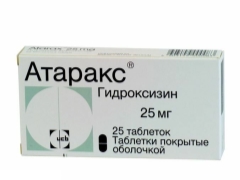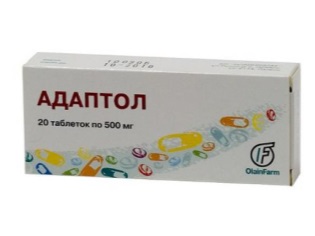Atarax children: instructions for use, reviews
Childhood disorders often require the use of drugs called anxiolytics. Their main effect is to reduce anxiety and fears. One of these tools is Atarax. Is it possible to give it to a child when it is worth doing it and in what dosage to use when treating children?
Release form
The drug is made:
- In tablets. This form of Atarax is represented by oblong tablets, on which there is a transverse separation risk. These tablets are covered with a white shell and placed in blisters of 25 pieces. One cardboard pack includes 1 blister.
- In solution. This clear, colorless liquid is intended for intramuscular injections, therefore poured into 2 ml ampoules. One pack contains 6 ampoules.
Composition
Atarax active ingredient is represented by hydroxyzine in the form of hydrochloride. This compound contains 25 mg per tablet, and 50 mg per 1 ml injectable form (100 mg in one ampoule of medication).
The tablet form of the drug further includes silicon anhydride, lactose, microcrystalline cellulose, and other substances that provide tablets with hardness and shape. In Atarax solution, only sodium hydroxide and sterile water act as auxiliary components.
Operating principle
The main ingredient of Atarax is a histamine receptor blocker (H1 receptor). He has a sedative effect. It is thanks to him that the medicine is considered an anxiolytic. The drug helps:
- Soothe the alarm.
- Reduce manifestations of excitation of the nervous system.
- Eliminate the feeling of internal tension.
- Reduce irritability.
- Improve memory and attention.
However, this drug does not provoke addiction, and if you take it for a long time, the completion of treatment does not lead to withdrawal syndrome.
Also, Atarax has properties to expand the bronchi, block vomiting and reduce the secretion of gastric juice. In allergic skin diseases, the active ingredient Atarax effectively eliminates itching.
Indications
In childhood Atarax is often prescribed to eliminate the itch-induced allergy. This medication is also often included in the range of tools used in surgical treatment.
In neurology, Atarax is used:
- When neurosis.
- With organic pathologies of the central nervous system, a symptom of which is nervous excitement and anxiety.
- After concussion or contusion of the brain, if the child has anxiety and other nervous disorders.
- With neurotic enuresis.
- When panic attacks, manifested by lack of air, nausea, dizziness, fear of death and other symptoms.
- In genetic disorders of the CNS, for example, in Tourette's disease.
For details on the use of the drug Atarax, see the video:
At what age is it allowed to take?
Instructions for use Atarax prohibits the treatment of such a drug babies up to a year. Children at the age of 1 year can be prescribed only as intramuscular injections. Take Atarax inside can be children who are 3 years old. In this case, to give such a medicine without consulting a doctor is not recommended.
Contraindications
The use of Atarax in children is prohibited not only at an early age, but also in case of hypersensitivity to its active substance. You should not give medicine and intolerance to aminophylline, cetirizine or ethylenediamine.
Due to the presence of lactose in the composition of the tablets are not prescribed for problems with the exchange of galactose or glucose. The injection form of the drug should not be injected into a vein, artery or under the skin. Also contraindicated for the treatment of atarax is porphyria. Adults are not prescribed this medicine during pregnancy and breastfeeding.
If a child has impaired liver function or has developed renal failure, the dosage of Atarax should be reduced. Dosage disorders, hyperthyroidism, and cardiovascular diseases in a child also require dose adjustment and attention to a pediatrician.
Side effects
The most frequent negative effect of treatment with Atarax is drowsiness and a feeling of inhibition. Also, many patients have headaches and fatigue from taking this drug.
Less commonly, the drug provokes:
- Allergy.
- Insomnia.
- Nausea
- Dizziness.
- Tremor.
- Dermatitis.
- Excited state.
- Confused consciousness.
- Cardiopalmus.
- Temperature rise.
- Cramps.
- Lowering blood pressure.
- Constipation.
- Vomiting.
- Urination disorders
- Soreness at the injection site (for injections).
Very rare side effects include angioedema, anaphylaxis, bronchospasm, hallucinations, problems with vision and orientation in space. Sometimes Atarax causes hepatitis.
Instructions for use and dosage
- The daily dose of Atarax in case of itching is calculated according to the body weight of the baby. At the age of 1-6 years, it ranges from 1 to 2.5 mg of the active compound of the drug for each kilogram of weight, and for children over six years of age - from 1 to 2 mg. The calculated amount is divided into several stages.
- If the agent is used during surgical treatment, the dosage will be 1 mg per kg of body weight of the child. This amount of Atarax give an hour before the operation.
- How long a child needs to take the remedy is in each case determined by the doctor individually.
Overdose
If you give the child Atarax in a larger dose than prescribed, it will adversely affect the state of the central nervous system, causing nausea, palpitations, fever, drowsiness. Serious poisoning will lead to tremor, hallucinations, depression of consciousness, arrhythmias, respiratory failure and even coma.
If the drug has been taken internally and an overdose is detected immediately, gastric lavage is performed and immediately called an ambulance. Doctors, if necessary, will perform intubation and will monitor the respiratory activity and blood circulation, as well as prescribe symptomatic means.
Interaction with other drugs
If you take Atarax along with other drugs that have a depressant effect on the nervous system, this therapeutic effect will increase. This interaction is noted in barbiturates, hypnotics, tranquilizers and narcotic analgesics.
You should not simultaneously prescribe Atarax and anticholinergics or combine this drug with MAO inhibitors. Treatment with antihypertensive drugs, H2-histamine blockers, atropine or cardiac glycosides does not affect Atarax.
Terms of sale
To buy Atarax in a pharmacy, you need to show a prescription prescribed by your doctor. The price of 25 tablets of this drug is about 280-300 rubles.
Storage conditions and shelf life
The medicine should be kept in a place inaccessible to small children, where the temperature will not exceed + 25 ° С. Treatment with Atarax, which has a shelf life of 5 years, is not recommended.
Reviews
On the application of Atarax in childhood there are different opinions. Reviews of doctors about this medicine are mostly positive, and mothers speak about it both well and negatively. According to many parents who gave Atarax to children, taking the medicine reduced irritability and anxiety, improved sleep, helped get rid of tearfulness, nervousness and moodiness.
Nevertheless, there are also reviews in which they complain of adverse reactions, and some mothers are afraid of the strong effect of Atarax and refuse to be treated with such a remedy in favor of herbal or homeopathic remedies.
Analogs
Atarax may be replaced by the drug Hydroxysin Canon, manufactured in coated tablets. He has the same active compound and the same indications for use. Also, instead of Atarax, neurologists often prescribe:
- Phenibut. This drug is used for fear, anxiety, insomnia, tics, motion sickness and other nervous disorders. The drug is represented by pills that can be given to children aged 2 years and older.
- Adaptol. Such tablets are often prescribed for children with stuttering, tikah and other neurological problems. According to the instructions of the neurologist, it is permissible to give them from 8-9 years of age.
- Noofen. This medicine in capsules is used in the treatment of tics, asthenia, anxiety, neurosis, enuresis and other nervous disorders in children over 8 years old.
- Anvifen. Such capsules give children 3 years and older with neurosis, tics, hemming, dizziness, and other problems with the nervous system.





















